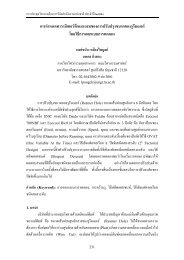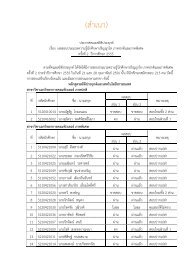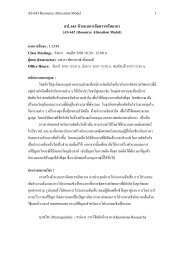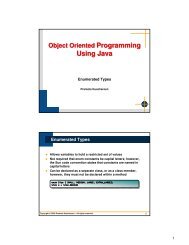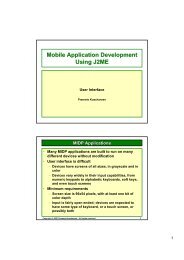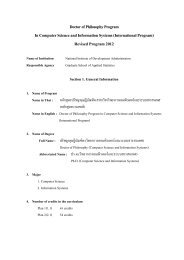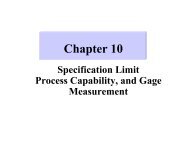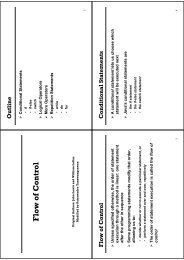ดาวน์โหลด All Proceeding - AS Nida
ดาวน์โหลด All Proceeding - AS Nida
ดาวน์โหลด All Proceeding - AS Nida
Create successful ePaper yourself
Turn your PDF publications into a flip-book with our unique Google optimized e-Paper software.
formulate a model of the expected value of a dependent process<br />
variables or responses y in term of the value of an influential process<br />
variable of x’s. In multiple linear regression, the model<br />
∑<br />
=<br />
k<br />
0<br />
i 1<br />
i i<br />
y= β + β x + ε<br />
(1)<br />
is performed, where ε is an unobserved random with mean<br />
zero conditioned on a scalar influential process variables of x’s model.<br />
In this model, for each unit increase in the value of x, the conditional<br />
expectation of y increases by βi units of x i . Conveniently, these<br />
models are all linear from the point of view of estimation, since the<br />
regression model is linear in terms of the unknown parameters βi .<br />
Therefore, for least squares analysis, the computational and inferential<br />
problems of multiple regressions can be completely addressed using the<br />
multiple regression techniques. This is done by treating x, x 2 , ... as<br />
being distinct independent process variables in a multiple regression<br />
model.<br />
In this research, there are five process variables and the<br />
objective is to focus on the only one response of y but there are some<br />
qualitative process variables that need to be in form of integer whereas<br />
the remaining process variables are qualitative. The mixed integer linear<br />
constrained response surface optimization model (MI-LCRSOM) is<br />
then applied to this problem of interest. The detail of sequential<br />
procedure for setting up the optimum value via a relationship of<br />
significant process variables and responses are expressed. Firstly, the 2 k<br />
factorial design was applied to preliminarily study the effects of those<br />
process variables. The multiple regression models of those responses<br />
were then developed from only significant process variables affecting<br />
the response. Finally, the regression model in forms of the path of<br />
steepest descent was placed as the objective function of the linear<br />
constrained response surface optimizations model to meet the<br />
meandering target subject to the limitation from feasible ranges of<br />
significant process variables including the specific integer values for<br />
some process variables.<br />
47<br />
4. EXPERIMENTAL RESULTS AND ANALYSES<br />
In the preliminary study, a two level experimental design<br />
was performed to determine the statistically significant from five<br />
process variables which consist of the scanning height (A), scanning<br />
power # 1 (B), scanning power # 2 (C), beam shape (D) and scanning<br />
speed (E). The feasible ranges, the current operating condition and type<br />
of process variables are provided in Table 2.<br />
Table 2. Process Variables, Feasible Ranges and the Current Operating<br />
Condition.<br />
Process Variable<br />
Feasible Range<br />
Lower Upper<br />
Current Type<br />
A 1 7 4 Qualitative<br />
B 0.12 0.48 0.24 Quantitative<br />
C 0.18 0.72 0.36 Quantitative<br />
D 1 3 1 Qualitative<br />
E 100 300 300 Quantitative<br />
At this step, the objective of using a factorial experimental<br />
design is to analyze both main and interaction effects of all process<br />
variables. The 2 5 experimental designs with two replicates provide 64<br />
treatments. The two level of low and high were selected cover values of<br />
feasible ranges from the actual operating conditions in production line<br />
and the responses were measured from the meandering data average of<br />
each cutting line. By using a general linear model from the analysis of<br />
variance (ANOVA), sources of variation focusing on the main and<br />
interaction effects and their P-values are shown in Table 3. The<br />
significant factor of main effect consist of A, B, C and D as the P-value<br />
is less than or equal to 0.05 and the interaction effect of AB, AC, BC,<br />
BD, CD are also statistically significant at 95% confidence interval.<br />
Table 3. Sources of Variation Focusing on Main and Interaction Effects<br />
and their P-values.<br />
Source of Variation P-value<br />
A 0.000<br />
B 0.000<br />
C 0.000




